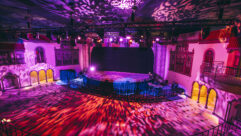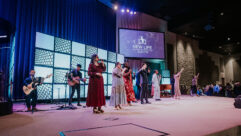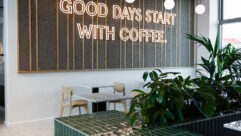
It’s Frank Sinatra’s centenary and to mark his 100th birthday the legendary singer played the London Palladium. “Sinatra: The Man & His Music” brought Old Blue Eyes to life more than 60 years after the celebrated entertainer played the venue. d3 and its creative software suite helped Fifty Nine Productions, Ltd. deliver the show’s complex visual media content to packed houses of fans.

Although the show featured a dance company and a full band, Sinatra appeared only as video elements in archival photos and video supplemented by original animations and graphics. “We were commissioned to design and create all the visual content that interacted with the scenic design by Stufish,” says Leo Warner, one of the directors Fifty Nine Productions, Ltd. “We built a multi-layered world, a dramatic and kinetic visual space around Frank singing. Almost all of the video elements moved with the exception of the upstage cyc.”
The entire stage served as a projection surface. A wide, ultra-HD cyclorama behind the band was the dominant video display surface. In front of the bandstand nine 9-meter, roll-drop gauze blinds flew in and out in different configurations, each one a projection surface. “They really brought the projected content close to the audience. We could play with up to three layers of projected depth: the downstage gauze, the roll-drops and the cyc, and amongst all that we could mix in the live band and the dancers – both made visible trough the gauze as required by the spectacular work of the lighting department,”
Warner explains.
Beneath the elevated bandstand at stage level were 18 rotating LED panels; the backs of the panels were covered with blue velvet and LED strip lighting. Six of the center panels moved on and offstage, allowing performers and set pieces to enter and exit. A standard gauze front-projection surface was positioned downstage. The floor also acted as a projection surface; in numbers that featured video only it “kept the dynamics of the presentation alive,” Warner notes.
“This show had a potentially overwhelming volume of material locked to time code, and we needed to edit and make changes to the content quite late in the day,” says Warner. “The time line and multi-user functionalities of d3 and its motion-control tracking capabilities made it the obvious choice for us.
“This was the first major show I’ve done on d3, and I couldn’t have done it any other way. I never struggled with the user interface; it was easy for me and for our technical director/programmer, Jonathon Lyle. d3 also supported making modifications to the software so we could do what we needed to do.”
Fifty Nine Productions used three d3 Designers, the software-only version of the d3 production suite, in prepro. To run the show one d3 4x4pro master, three slaves and one understudy were deployed.
Full-scale tech rehearsals ran four weeks at the LH2 rehearsal facility in London. Three more days were spent rehearing at the venue. “The ability to pre-program before rehearsals with a relatively accurate 3D model of the set was huge,” Warner says.
“Working in the 3D visualizer we were able to previsualize automation moves for the dancers before the automation department programmed them in,” he explains. “We could keep up with or even be ahead of other departments and offer them assistance before making show-changing decisions. That’s pretty extraordinary. The director, David Gilmour, was so impressed by d3 that he wanted one to take home!”
The MultiEdit Collaboration feature, whereby multiple laptops with d3 Designer can join a session hosted on a d3 rackmount server and continue to work on the show, also proved to be a big asset. “I could work with the director on bits not running on the stage at the moment and make live updates to the main server,” he explains.
In addition, “The multi-user editability of the time line enabled Jonathon and I to work on the same bits of the show live without conflicts in programming,” he says. “It’s incredibly efficient to have many hands working at the same time. It meant we could build complex bits of the show almost without effort.”
“d3 facilitated a new workflow for Leo and I, allowing the designers to directly interact with the programming in an intuitive way,” says Jonathon Lyle. “The system automatically calculated many of the time-consuming tasks such as masking scenery as it moved through images, enabling us to focus on the creative storytelling.”
SockPuppet DMX allowed the team to create intuitive controls for the lighting departmemt. “They could interact with the system through their lighting console,” explains Lyle. “In addition, we received data from the automation department, which allowed us to track the complex choreography of scenic elements, including the roller blinds and hero screens. Dynamic Blend allowed us to utilize a number of projectors on each surface.”
d3 staff members also provided custom software modifications. The show’s need to ingest new content on a very frequent basis sparked the development of the Content Management feature, which is available to all d3 users in the new r12 software release.
“The ability to ingest new content quickly and to create a versioning system for that content sounds boring, but it’s revolutionary,” says Warner. “We had eight content developers on site during the entire prepro process. So there was constant data and information – we could have 15-20 new pieces of content going into the system on each rehearsal day. It was critical to stay on top of that.”
Nine projectors were deployed for the show: three on the cyc, three on the roller blinds, one on the downstage gauze and two on the floor. “The whole show integrates the live band with video of Frank, so time code from the sound department is the absolute backbone of the show: Synching video to it was critical,” says Warner.
d3 customized software to calculate frame delays between the projectors and the LED panels that made synching the entire show an easy process. “Once we set the synch delay relative to the sound it applied across the whole show,” Warner explains. “We didn’t have to tweak the synch for every song.
“The backbone of the show was built around amazing archive material of Frank, around which we built over two hours of continuous, multi-plane scenic and narrative video projection. That comprised vast amounts of data and a huge number of pixels,” he emphasizes. “d3 let us focus on whether our ideas were right, not whether the technology would work. And that was the end goal.”
About d3
d3 is the world’s first fully integrated visual production system for video professionals, combining a real-time 3D stage visualizer, timeline, video playback engine and projection mapping tools into one product. d3’s unique integrated workflow assists the designer at all stages of the project, from pitch through development to final delivery. For more information visit www.d3technologies.com










